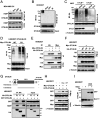Reciprocal interplay between OTULIN-LUBAC determines genotoxic and inflammatory NF-κB signal responses
- PMID: 35939695
- PMCID: PMC9388121
- DOI: 10.1073/pnas.2123097119
Reciprocal interplay between OTULIN-LUBAC determines genotoxic and inflammatory NF-κB signal responses
Abstract
Targeting nuclear factor-kappa B (NF-κB) represents a highly viable strategy against chemoresistance in cancers as well as cell death. Ubiquitination, including linear ubiquitination mediated by the linear ubiquitin chain assembly complex (LUBAC), is emerging as a crucial mechanism of overactivated NF-κB signaling. Ovarian tumor family deubiquitinase OTULIN is the only linear linkage-specific deubiquitinase; however, the molecular mechanisms of how it counteracts LUBAC-mediated NF-κB activation have been largely unknown. Here, we identify Lys64/66 of OTULIN for linear ubiquitination facilitated in a LUBAC-dependent manner as a necessary event required for OTULIN-LUBAC interaction under unstressed conditions, which becomes deubiquitinated by OTULIN itself in response to genotoxic stress. Furthermore, this self-deubiquitination of OTULIN occurs intermolecularly, mediated by OTULIN dimerization, resulting in the subsequent dissociation of OTULIN from the LUBAC complex and NF-κB overactivation. Oxidative stress induces OTULIN dimerization via cysteine-mediated covalent disulfide bonds. Our study reveals that the status of the physical interaction between OTULIN and LUBAC is a crucial determining factor for the genotoxic NF-κB signaling, as measured by cell survival and proliferation, while OTULIN loss of function resulting from its dimerization and deubiquitination leads to a dissociation of OTULIN from the LUBAC complex. Of note, similar molecular mechanisms apply to the inflammatory NF-κB signaling in response to tumor necrosis factor α. Hence, a fuller understanding of the detailed molecular mechanisms underlying the disruption of the OTULIN-LUBAC interaction will be instrumental for developing future therapeutic strategies against cancer chemoresistance and necroptotic processes pertinent to numerous human diseases.
Keywords: LUBAC; NF-κB; OTULIN; deubiquitinases; inflammation.
Conflict of interest statement
The authors declare no competing interest.
Figures






Similar articles
-
Suppression of LUBAC-mediated linear ubiquitination by a specific interaction between LUBAC and the deubiquitinases CYLD and OTULIN.Genes Cells. 2014 Mar;19(3):254-72. doi: 10.1111/gtc.12128. Epub 2014 Jan 26. Genes Cells. 2014. PMID: 24461064
-
Non-proteolytic ubiquitination of OTULIN regulates NF-κB signaling pathway.J Mol Cell Biol. 2020 Apr 24;12(3):163-175. doi: 10.1093/jmcb/mjz081. J Mol Cell Biol. 2020. PMID: 31504727 Free PMC article.
-
LUBAC and OTULIN regulate autophagy initiation and maturation by mediating the linear ubiquitination and the stabilization of ATG13.Autophagy. 2021 Jul;17(7):1684-1699. doi: 10.1080/15548627.2020.1781393. Epub 2020 Jun 26. Autophagy. 2021. PMID: 32543267 Free PMC article.
-
Biochemistry, Pathophysiology, and Regulation of Linear Ubiquitination: Intricate Regulation by Coordinated Functions of the Associated Ligase and Deubiquitinase.Cells. 2021 Oct 9;10(10):2706. doi: 10.3390/cells10102706. Cells. 2021. PMID: 34685685 Free PMC article. Review.
-
Linear ubiquitination-mediated NF-κB regulation and its related disorders.J Biochem. 2013 Oct;154(4):313-23. doi: 10.1093/jb/mvt079. Epub 2013 Aug 21. J Biochem. 2013. PMID: 23969028 Review.
Cited by
-
OTULIN Can Improve Spinal Cord Injury by the NF-κB and Wnt/β-Catenin Signaling Pathways.Mol Neurobiol. 2024 Nov;61(11):8820-8830. doi: 10.1007/s12035-024-04134-3. Epub 2024 Apr 2. Mol Neurobiol. 2024. PMID: 38561559 Review.
-
Exploring necroptosis: mechanistic analysis and antitumor potential of nanomaterials.Cell Death Discov. 2025 Apr 29;11(1):211. doi: 10.1038/s41420-025-02423-x. Cell Death Discov. 2025. PMID: 40301325 Free PMC article. Review.
-
Deubiquitinases as novel therapeutic targets for diseases.MedComm (2020). 2024 Dec 13;5(12):e70036. doi: 10.1002/mco2.70036. eCollection 2024 Dec. MedComm (2020). 2024. PMID: 39678489 Free PMC article. Review.
-
Friend or foe? Reciprocal regulation between E3 ubiquitin ligases and deubiquitinases.Biochem Soc Trans. 2024 Feb 28;52(1):241-267. doi: 10.1042/BST20230454. Biochem Soc Trans. 2024. PMID: 38414432 Free PMC article. Review.
-
NF-κB in biology and targeted therapy: new insights and translational implications.Signal Transduct Target Ther. 2024 Mar 4;9(1):53. doi: 10.1038/s41392-024-01757-9. Signal Transduct Target Ther. 2024. PMID: 38433280 Free PMC article. Review.
References
Publication types
MeSH terms
Substances
Grants and funding
LinkOut - more resources
Full Text Sources
Molecular Biology Databases

